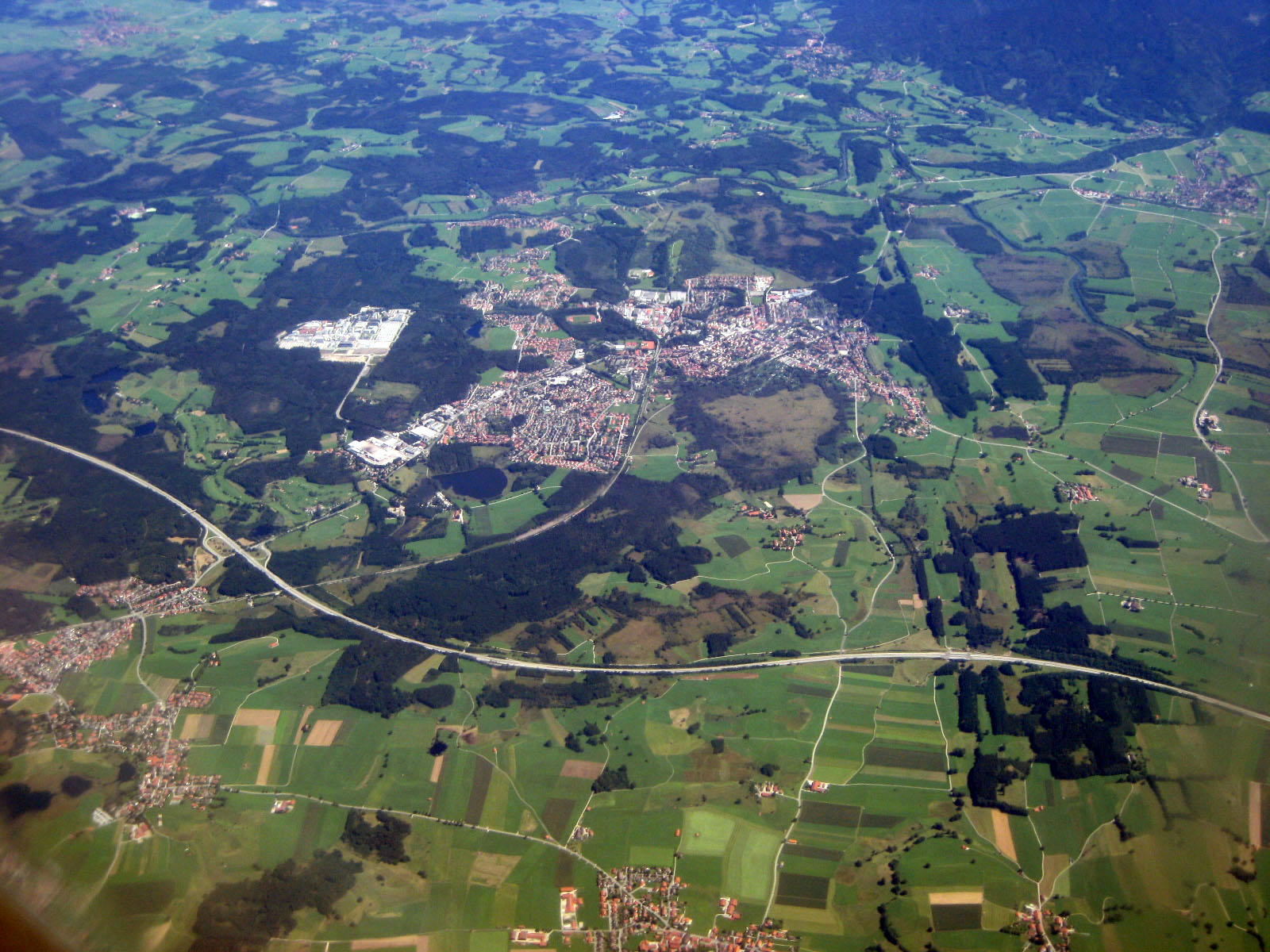 15-August-2007. A couple of weeks ago we read about soaring heat, a blackout in Barcelona, an oil spill in the Mediterranean and giant schools of jellyfish lurking off the beaches waiting for the August holiday to bring them lots of fleshy bathers. It didn’t look like a good time for a visit to Spain. And to make matters worse, 7.5 million mouse-like rodents called voles were feasting on beets and potatoes in Spain’s agricultural heartlands. Yikes!! But heat never scared us off. And as far as we knew, the voles hadn’t come to the city yet. The flight into the Madrid was lush and green.It turned out to be a perfect time to be here. It’s quiet, the temperatures are hitting lows 80’s°F in the days and down to a comfortable mid 60s F° at night. And the city is empty. Nothing can keep the Madrilenos from their holidays at the beach; not soaring heat, not blackouts, not voles, not even Jellyfish.
15-August-2007. A couple of weeks ago we read about soaring heat, a blackout in Barcelona, an oil spill in the Mediterranean and giant schools of jellyfish lurking off the beaches waiting for the August holiday to bring them lots of fleshy bathers. It didn’t look like a good time for a visit to Spain. And to make matters worse, 7.5 million mouse-like rodents called voles were feasting on beets and potatoes in Spain’s agricultural heartlands. Yikes!! But heat never scared us off. And as far as we knew, the voles hadn’t come to the city yet. The flight into the Madrid was lush and green.It turned out to be a perfect time to be here. It’s quiet, the temperatures are hitting lows 80’s°F in the days and down to a comfortable mid 60s F° at night. And the city is empty. Nothing can keep the Madrilenos from their holidays at the beach; not soaring heat, not blackouts, not voles, not even Jellyfish.
Spain is the fastest growing country in Western Europe. After 35 years of Franco’s economic depression, this country came charging out of the gate like a ferocious bull. You can’t look up without seeing a giant construction crane over any city or town.
One of the newest building projects in Madrid is the airport. Unfortunately though, they are still using it while they’re tearing it apart, passengers huddled under dangling metal rods, cut wires and visqueen walls waiting to board their flight. It almost looks like a war zone. The renovation is causing a lot of inconvenience to the passengers but it also gave the airport an excuse to get rid of a lot of useless crap. On May 22nd of this year more than 20,000 items people left on planes or in the airport were auctioned off cleaning out its lost-and-found department. The list included 6,330 books, 664 toys, 1,570 audio or video gadgets, 38 cartons of cigarettes, several surfboards, a bass guitar, a wedding dress, and a pair of stilts with sneakers on the bottom.
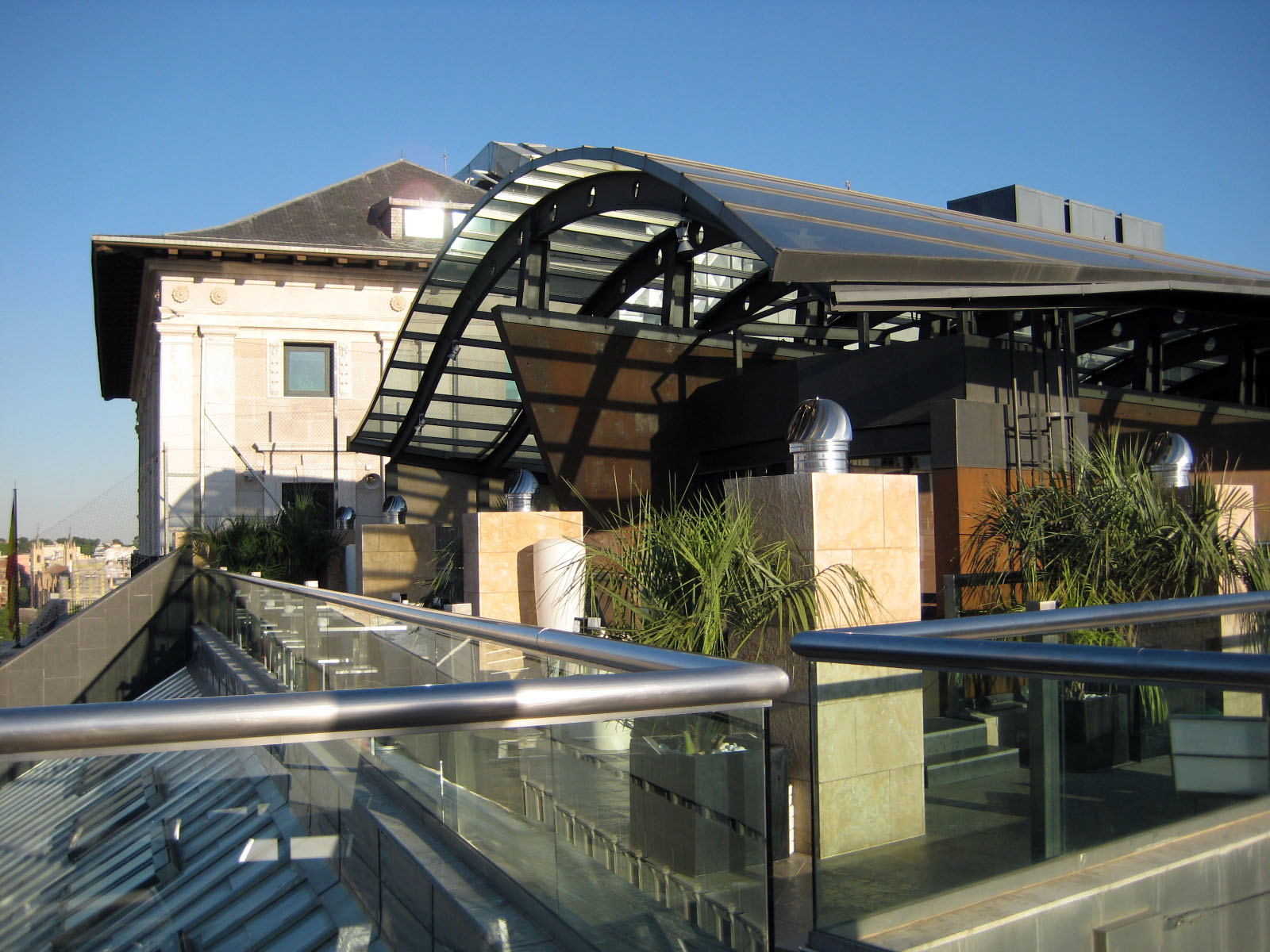 We’re back at the Hotel Urban, an architecturally modern hotel a few blocks from everywhere we like to be, the Plaza Mayor, Puerta del Sol, the Prado Museum, and the great cafes, restaurants and tapas bars around the Plaza Santa Ana.
We’re back at the Hotel Urban, an architecturally modern hotel a few blocks from everywhere we like to be, the Plaza Mayor, Puerta del Sol, the Prado Museum, and the great cafes, restaurants and tapas bars around the Plaza Santa Ana.
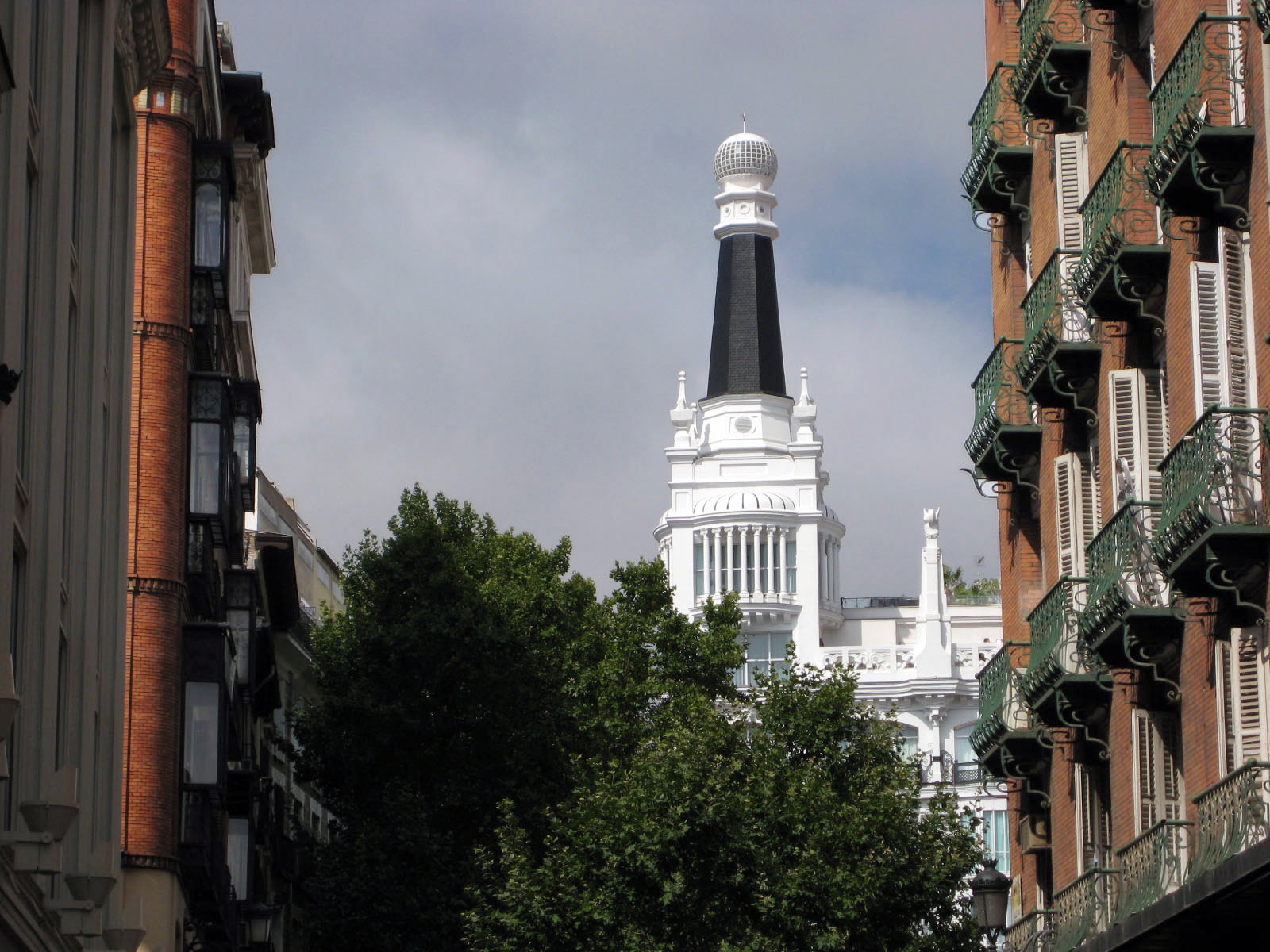 In 1993, we stayed in the middle of Plaza Santa Ana, at the 19th century Reina Victoria Hotel. We heard that all the hotels named after Queen Victoria (built during her reign) were built when the Queen announced she would be coming for a visit.
In 1993, we stayed in the middle of Plaza Santa Ana, at the 19th century Reina Victoria Hotel. We heard that all the hotels named after Queen Victoria (built during her reign) were built when the Queen announced she would be coming for a visit.
We have no idea if Queen Victoria did ever stayed in this hotel, but we did know it used to be a favorite haunt of Ernest Hemmingway and Manolete, perhaps the most famous bullfighter in the history of Spain. When we were here, the lobby was still filled with old 1940’s photos of the Great Manolete. There were even a couple of heads of the bulls that fell to the “estocata” (thrust) of Manolete’s sword.
A couple of years ago, the hotel was purchased by the Melia Hotel chain. Last year when we were here it was under the wraps of renovation. This year the new hotel was revealed. It looks exactly like the old exterior but the interior is a nasty disco version of Spanish Modern. The receptionist told us the hotel is called “ME” which stands for the Melia Experience. All the photos of Manolete are gone. The bulls are gone. All the charm is gone. This is the Melia Experience.
On the other hand, the Hotel Urban is wonderful and highly recommended, especially during the off season when it’s affordable. The rooms here are spacious, well designed and very clever. It’s one of those hotels you go around saying, “wow, look at this: for a least the first 5 minutes after you check in. It’s much different from staying at a modern hotel in the US, or anywhere else we’ve been for that matter.
Spanish design these days is really exciting. Just check out the work of Santiago Calatrava.
 But enough of modern Spain. Let’s go back to the 16th century.
But enough of modern Spain. Let’s go back to the 16th century.
The first place we always head for is the 16th Plaza Mayor. In 1560, Juan de Herrera (the architect of El Escorial and Segovia) under King Felipe II began the project to transform the old marketplace into a grand square; 57 years later it was completed, but then after several fires it was rebuilt again.
The grand Plaza has been used for coronations, bullfights, celebrations and public executions with as many as 50,000 spectators. The most famous of the public executions were Inquisitions known as “Auto de Fe”. These cleansings of heretics started in the 15th century under Isabel and Ferdinand but whenever the Church felt it was loosing absolute control over the people, they were brought back.
Check out he 1683 painting by Francisco Ricci of the Auto de Fe in Plaza Mayor on June 30, 1680. After the sentencing, the condemned were turned over to civil authorities. If they repented, they were killing by garroting and then their bodies were burned at the stake. If they didn’t repent, they were burned alive. Most of them repented.
At the center of the square is Juan de Bolonia’s 1616 bronze statue of King Felipe III. A Madrileno friend of ours told us that the horse was originally constructed with an open mouth but during a statue cleaning, workers discovered that pigeons entered the mouth and nested in the horse’s belly. The ones that couldn’t find there way out remained as a pile of little pigeon bodies. And so the horse (with Felipe III in tow) was removed, the pigeon remains were cleaned out and all was restored to the square, this time with the mouth closed.
King Felipe III is posed on the horse with one leg raised. According to statue symbolism, if the horse has one leg lifted it means the rider suffered injuries in battle but lived through the battle and died later from the wound. Both legs reared up in the air means the rider died in battle. Both legs on the ground mean he died a peaceful, natural death. Actually, Felipe III never had a wound from a battle. I don’t think he ever went into battle. He was a King in name only and left the ruling of the country to his subservient advisors. In fact, his death is attributed to intense heat from a “brasero” a charcoal heater because the proper servant wasn’t around to remove it. Yes, the King was too stupid and lazy to move himself away from the charcoal heater.
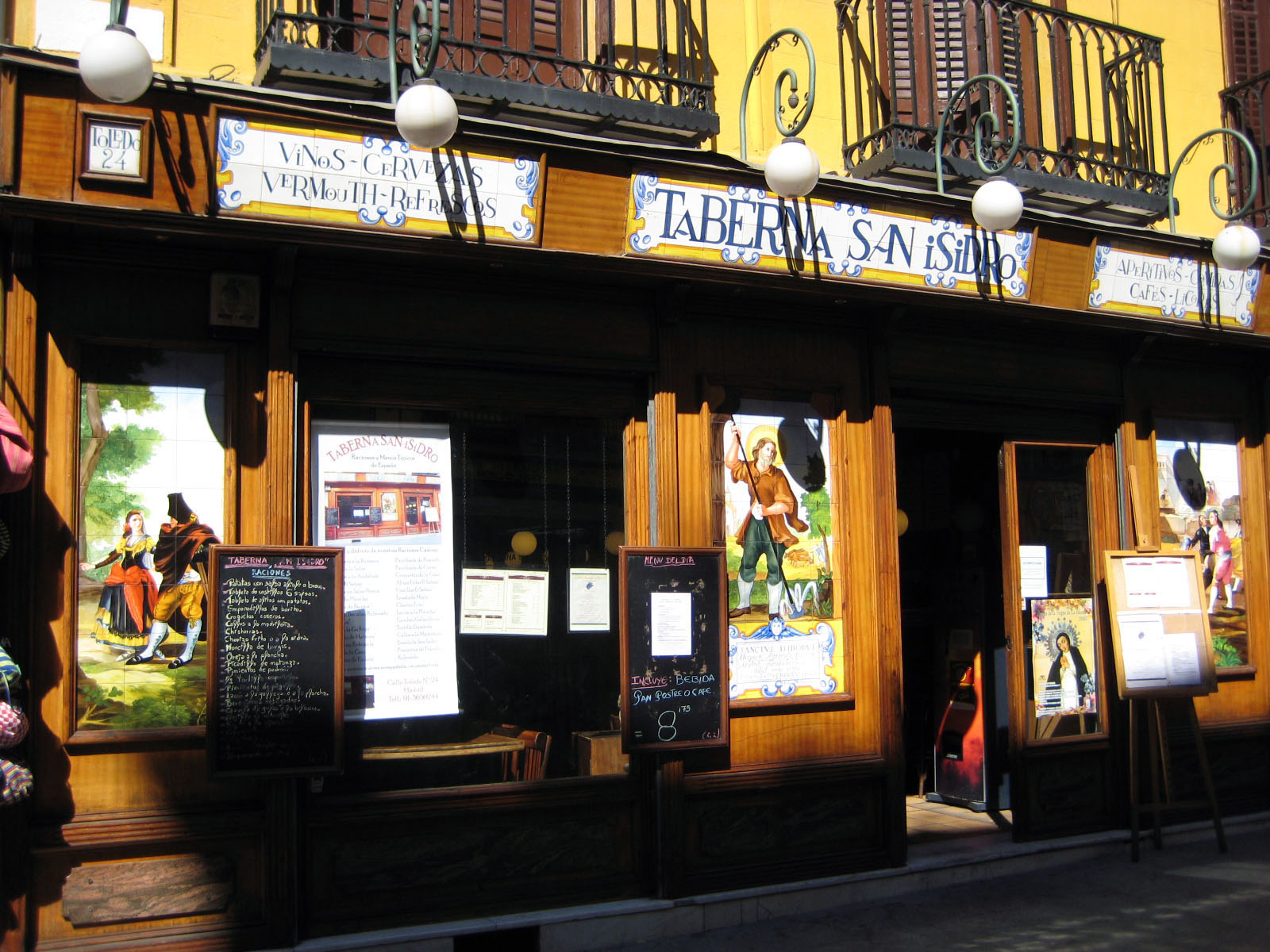 We really like walking around the old neighborhoods near Plaza Santa Ana and behind the Plaza Mayor. In August, like many cities in Europe, everything is quiet and empty. The old glazed tile restaurants glisten in reflections of the sun.
We really like walking around the old neighborhoods near Plaza Santa Ana and behind the Plaza Mayor. In August, like many cities in Europe, everything is quiet and empty. The old glazed tile restaurants glisten in reflections of the sun.
A Spanish classical guitarist echoed the sounds of ancient Spain across the courtyard the Palacio Reale, still the official residence of the King of Spain and royal family, even though they don’t use it these days except for state functions.
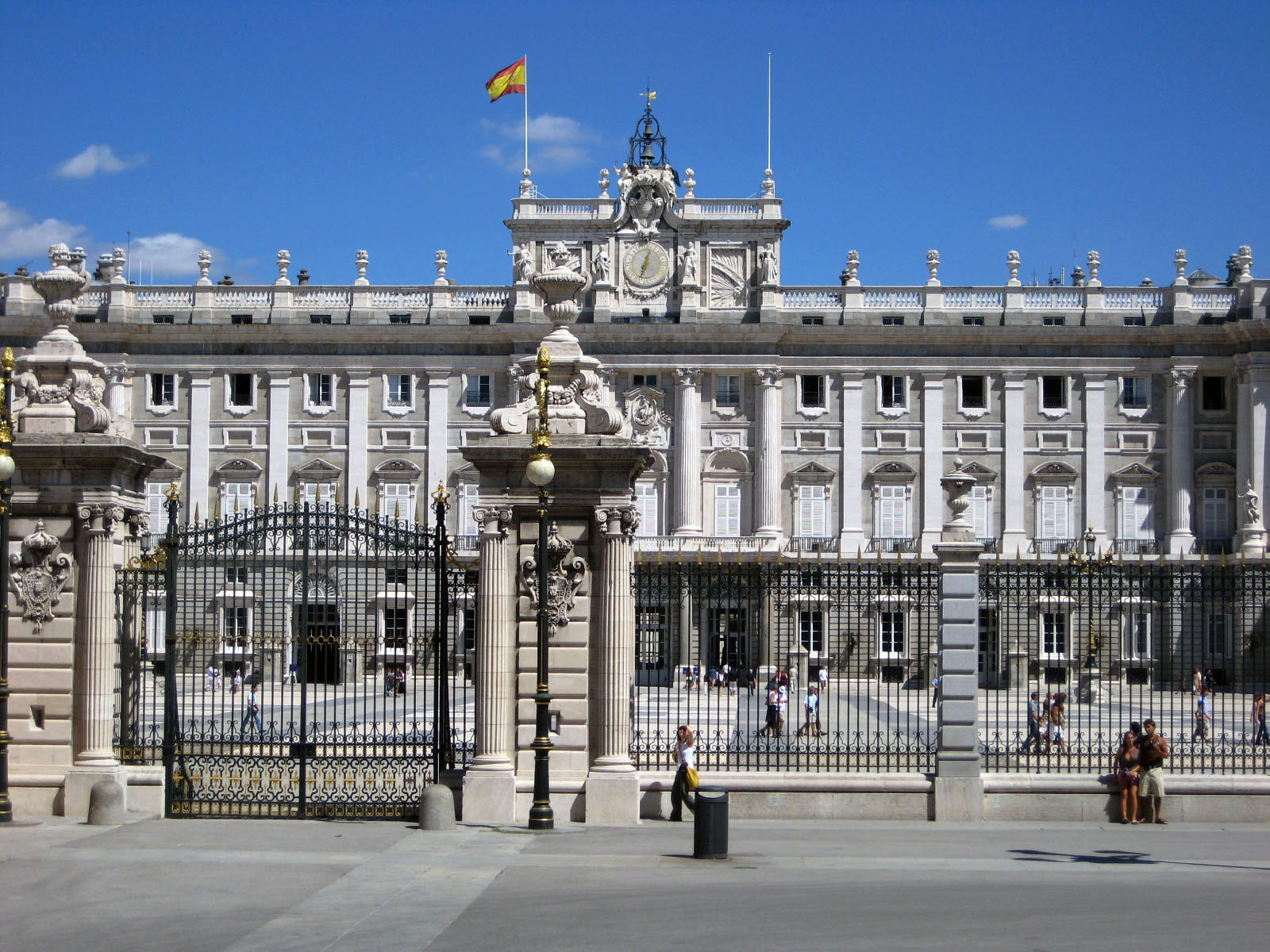 The Royalty of Spain is a mélange of pedigrees. The current King Juan Carlos I is descended from Queen Victoria of England, Louis XIV of France and Charles V, the Hapsburg Holy Roman Emperor, who himself was the grandson of Queen Isabella and King Ferdinand, who expelled the Moors, started the Inquisition and gave money to Columbus so he could find more wealth to support their reign of terror.
The Royalty of Spain is a mélange of pedigrees. The current King Juan Carlos I is descended from Queen Victoria of England, Louis XIV of France and Charles V, the Hapsburg Holy Roman Emperor, who himself was the grandson of Queen Isabella and King Ferdinand, who expelled the Moors, started the Inquisition and gave money to Columbus so he could find more wealth to support their reign of terror.
Charles V claimed to speak “Spanish to God, Italian to women, French to men, and German to my horse.” During his reign the territories of new Spain were extended by the conquistadores Cortes, Pizarro who pretty much wiped out the Aztec and Inca civilizations while providing an enormous treasure for Charles. Whopteedoo!! Spain was becoming the wealthiest country in Europe.
Charles V also suffered from an enlarged lower jaw, a deformity known as the Hapsburg chin or Hapsburg lip. Apparently, the deformity was so bad he couldn’t chew his food properly and consequently he usually ate alone. By the time Felipe IV came along, the Hapsburg chin reached it largest proportion (you can see some of Velasquez’s great portraits of him in the Prado). Felipe IV also felt the Hapsburg dynasty was getting old and needed a transfusion so he married Isabelle of Bourbon and started the Bourbon bloodline. And which with the few exceptions of Napoleon’s conquest and the 35 years of Franco’s rule, they are still the ruling power.
On July 17, 1936, a radio broadcast signaled the start of the Spanish Civil War with the announcement “Over all of Spain, the sky is clear”. It was the call to arms that pitted the Republicans (liberal democrats, anarchists, socialists and landless peasants) against the Nationalists (Francisco Franco, the fascists, the Catholic church, the Monarchy and the wealthy). Hemmingway, Picasso, Lorca and George Orwell were a few of the republican supporters. Salvador Dali was a nationalist, which is probably why he was treated so well during Franco’s reign.
By the time the war ended, the atrocities of both sides were astounding, some of them made the Auto de Fe’s of the 15th and 16th century look civilized. But in the end, “El Generalisimo” Franco’s Nationalists outlasted the Republicans.
Franco wasn’t too eager to give the country back to the Monarchy right away and instead named himself leader for life, a life that kept Spain in economic darkness for another 35 years.
However, he did decide than when he died, the old bloodlines to the King would be reinstated. But once again Franco had the last word. The King was supposed to be Don Juan de Borbon, the father of Juan Carlos and the eldest of the ruling monarchs in exile. But Franco never liked Don Juan, thinking he was too liberal, and so he gave the country over to his son.
King Juan Carlos I was crowned on November 22nd, 1975, 2 days after Franco’s death. He was 37 years old.
The first thing Juan Carlos I did in office was issue sweeping democratic reforms. He even brought socialists and communists into the state offices. Boy did that piss off the old fascists. El Caudillo’s (Franco) bones moaned in his grave.
In 1978 he felt he had done enough to get things going (and piss off the old fascists) and so he issued a proclamation giving up his absolute rule. He’s now a reigning Monarch but a non-ruling one.
In the past 30 years, Spain has prospered tremendously. When we first came here in 1994, this was the cheap place to visit in Europe. We could have bought a large house with swimming pool overlooking the Costa Blanca for $40,000. These days we keep asking ourselves, why didn’t we do it?
On our last day here, we spent the morning at the Prado, without question the best museum in Spain and one of the best in the world. There are over 8600 paintings here, including the largest collection of Velazquez, Goya, Ribera and Hieronymous Bosch, who apparently was a favorite of King Felipe II. Bosch’s “The Garden of Earthly Delights”, that bizarre three panel journey from birth to damnation has been used in everything from 1960’s Rock and Roll album covers to Bart Simpson’s nightmares. But it’s here in the Prado because it used to hang in King Felipe II’s bedroom. Talk about weird dreams..
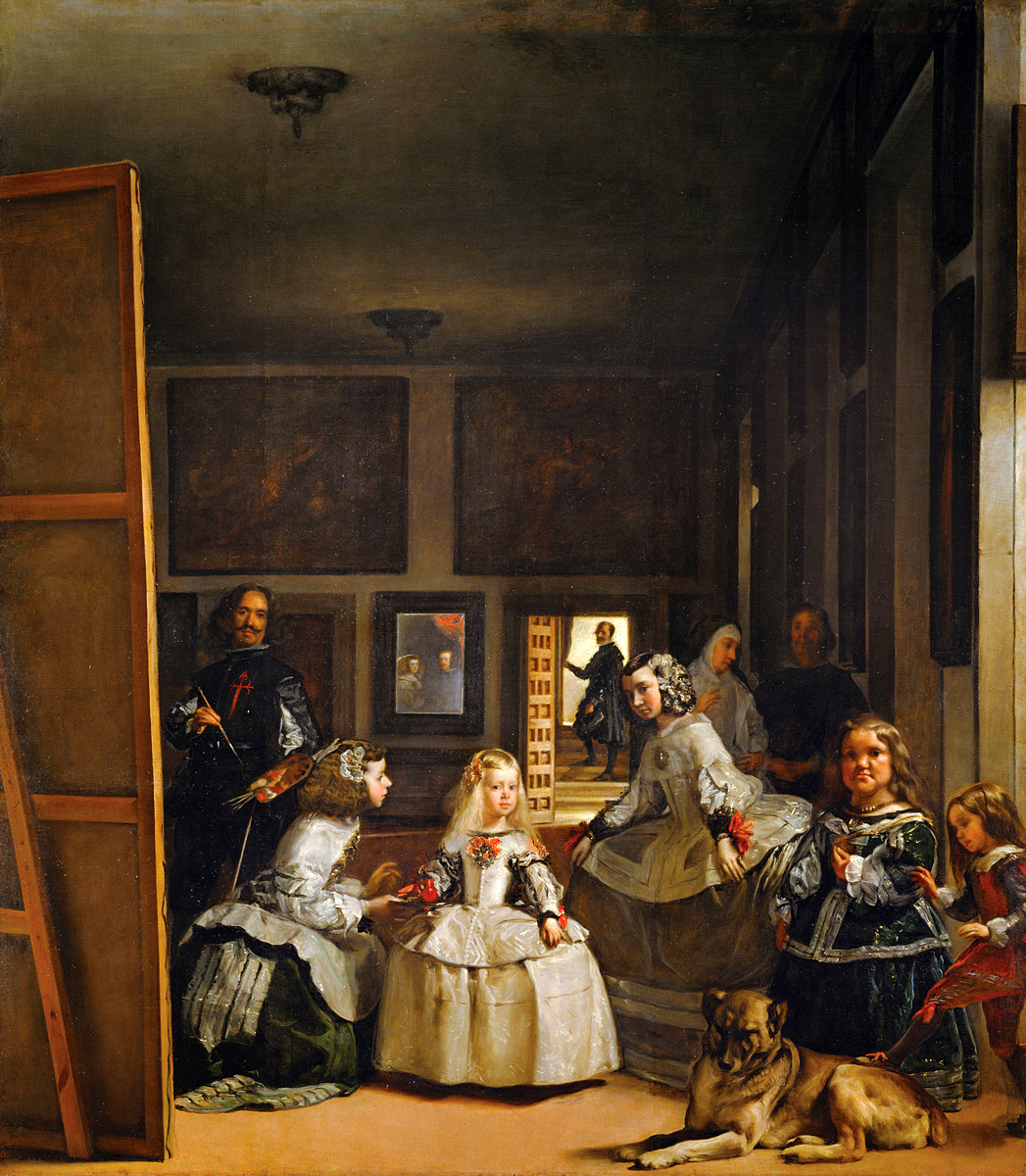 Even with just a short time there, we were able to pay our respects to the Velazquez rooms, including his masterpiece of Las Meninas, the portrait of the Infanta Margarita, the daughter of Felipe IV. The Infanta is surrounded by her ladies-in-waiting, her pet dwarf, Maribarbola, and her mastiff. King Felipe IV and his second wife, Mariana of Austria are seen in a doorway in the back of the painting, while Velázquez is seen standing at his easel painting the scene for us to see 300 years later. Pablo Picasso, painted a series of 58 versions of Las Meninas between August and December 1957. But you’ll have to go to the Picasso Museum in Barcelona to see them.
Even with just a short time there, we were able to pay our respects to the Velazquez rooms, including his masterpiece of Las Meninas, the portrait of the Infanta Margarita, the daughter of Felipe IV. The Infanta is surrounded by her ladies-in-waiting, her pet dwarf, Maribarbola, and her mastiff. King Felipe IV and his second wife, Mariana of Austria are seen in a doorway in the back of the painting, while Velázquez is seen standing at his easel painting the scene for us to see 300 years later. Pablo Picasso, painted a series of 58 versions of Las Meninas between August and December 1957. But you’ll have to go to the Picasso Museum in Barcelona to see them.
The Infanta Margarita might be so young and beautiful in the portrait, but she had a pretty sad life. At 15 years old she was awarded and betrothed to Leopold I of Austria, a short, ugly man who’s inbreeding had giving him the worst disadvantage of the Hapsburg chin. At age 22 she died in childbirth. There is another portrait of her at age 15 by the artist Juan Bautista Martínez del Mazo. She looks like she just go the news of her marriage. Boy is she depressed.
For us, she’ll always be remembered as the little girl in Velázquez’s masterpiece.
Diego Velázquez and King Felipe IV shared a very productive relationship. The king enjoyed the royal portraits and encouraged the painter to use his free time to explore his creativity, which might be why there are so many Velazquez paintings in the Prado Museum. It is said the king painted the honorary Cruz Roja (Red Cross) of the Orden de Santiago (Order of Santiago) on the breast of Velazquez as he appears in the painting of “Las Meninas”. Whether it’s true or not, it does show the admiration the King had for the painter.
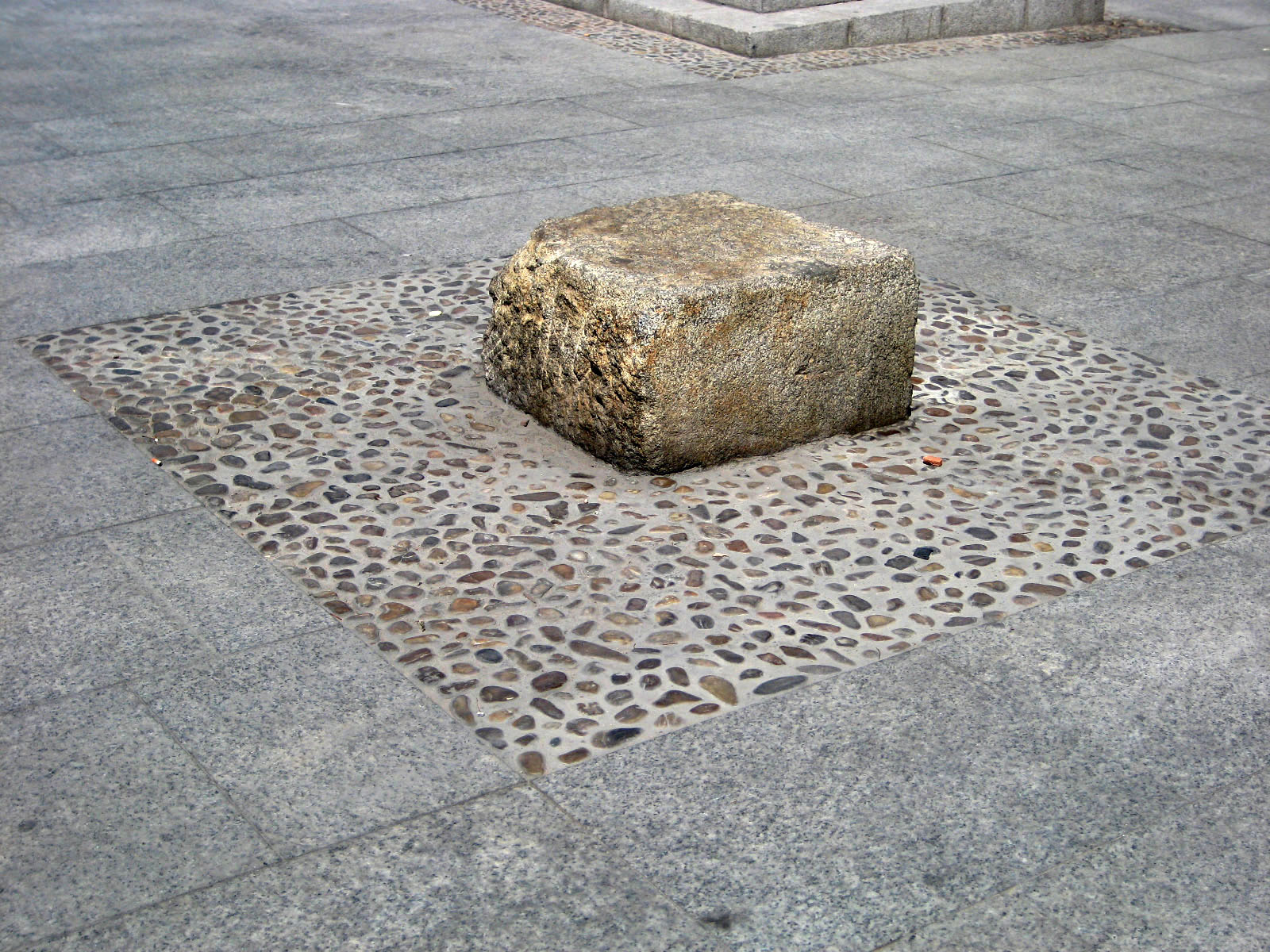 In the Plaza de Ramales, a short distance away from the Palacio Reale, there is a large square stone in the middle of the open square. This was once the location of the Church of San Juan. According to church records, Velázquez, dressed in a black cape and hat, was buried inside the church a day after his death in 1660.
In the Plaza de Ramales, a short distance away from the Palacio Reale, there is a large square stone in the middle of the open square. This was once the location of the Church of San Juan. According to church records, Velázquez, dressed in a black cape and hat, was buried inside the church a day after his death in 1660.
Francisco José de Goya’s relationship with the Borbon family of Charles IV was much different. We have no idea how he got away with it but all of his portraits of Charles IV and his family makes them look really idiotic. Who knows, maybe they were idiotic and liked the look. Afterall this is the King that lost the Spanish fleet at Trafalgar and the Spanish Throne to Napoleon.
Goya seems to have had mixed feeling about being a court painter. He did enjoy the reputation and the income but his relationship with the royals gradually went downhill, especially after Spanish Nationalists were slaughtered by the French on the 3rd of May in 1808.
The museum is a very good timeline and retrospect into the strange and ultimately sad life of Francisco José de Goya. You can see his life as a young inspired and happy artist through his complex life and all the way through his eventual madness.
His early works from around 1777 are happy scenes of the rural countryside when he was in his young 20’s. His fame as a portrait painter spread to the Royal family and he became the official court painter for King Carlos (Charles) IV. It was during hi time as a court painter when he began to court Doña María del Pilar Teresa Cayetana de Silva y Álvarez de Toledo, the 13th Duchess of Alba. He called her his muse. She and her husband, José Álvarez were both patrons of Goya and he (Goya) loved sending the Duchess erotic drawings at any chance he could find. The Goya portraits of the Maja (both nude and clothed) are thought to be the Duchess of Alba. They sure look like other portraits of her but it’s never been proven. In 1813 the nudes were confiscated by the Church in yet another Inquisition. Yes, they went on that long. King Ferdinand VII, the son of Charles IV wasn’t as fond of Goya as his father was but luckily both versions of the Duchess of Alba survived and they are both at the Prado museum. Try to get to see them early before the crowds are people stand in front of her vying to get their photo with the painting.
In 1792, at age 46, Goya went deaf after a bout with a very a high fever. He became withdrawn and depressed. He did return to Madrid briefly as the court painter or Ferdinand VII, but their relationship was never very cordial and he was getting more depressed. This period of his life he painted a few wonderful portraits of his maid Leocadia Weiss. There are stories that Leocadia looked so much like his wife Josefa that many art historians are still wondering who the woman was. After a turbulent relationship with Leocadia, he moved away from Madrid and began painting his famous “black paintings”. He was balancing on the border of insanity but his painting was still wonderfully expressive. Canvases like “Sarturn devouring his son” or “Two old men eating soup” have defined this period as possibly his best work.
Things got worse. In 1824 he moved to Bordeaux France. Between 1824 and 1828, he painting his darkest work directly onto the walls of his house, some say using only candles for light.
He died on April 16, 1828 of a stroke. Some say the cause was Encephalitis; others insist it was the lead in the paint.
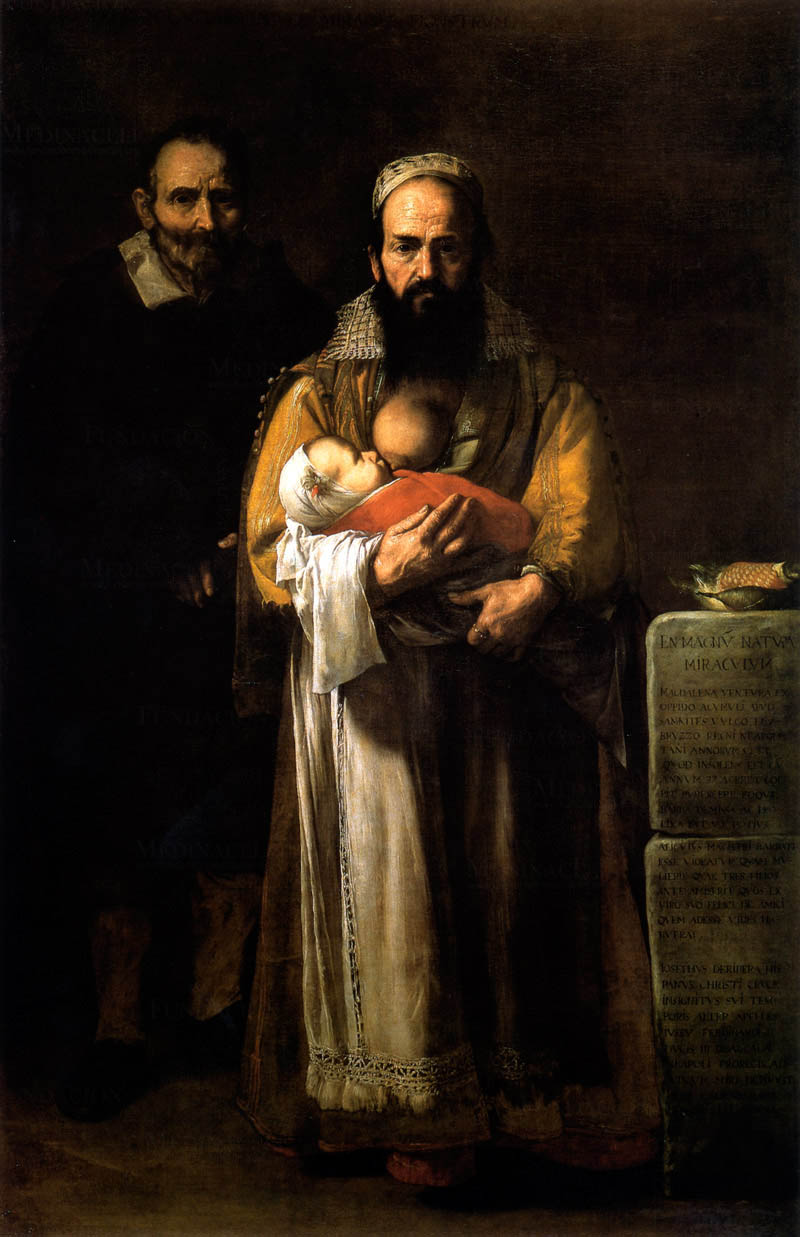 If you go to the Prado just for Velázquez or Goya could be enough, but there is so much more. Jose de Ribera was Spain’s finest Tenebrist (using dramatic contrast of light and dark) created his figures to look as if they were emerging from the dark. Caravaggio had mastered this style in Italy around the same time and Ribera was definitely a big fan of Caravaggio. It’s all over his work. One of our favorite Ribera paintings hanging in the Prado is the 1631 painting called “La Mujer Barbuda”. It shows the Maddalena Ventura, a 37 year old woman who (more or less) turned into a man. The Mujer poses for the painting standing next to her husband while nursing her child. It’s pretty weird.
If you go to the Prado just for Velázquez or Goya could be enough, but there is so much more. Jose de Ribera was Spain’s finest Tenebrist (using dramatic contrast of light and dark) created his figures to look as if they were emerging from the dark. Caravaggio had mastered this style in Italy around the same time and Ribera was definitely a big fan of Caravaggio. It’s all over his work. One of our favorite Ribera paintings hanging in the Prado is the 1631 painting called “La Mujer Barbuda”. It shows the Maddalena Ventura, a 37 year old woman who (more or less) turned into a man. The Mujer poses for the painting standing next to her husband while nursing her child. It’s pretty weird.
You must be logged in to post a comment.